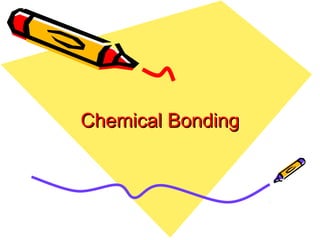Signaler
Partager

Recommandé
Contenu connexe
Tendances
Tendances (20)
En vedette
En vedette (20)
NJFuture Redevelopment Forum 13 Building Capacity Baumann-Domenick

NJFuture Redevelopment Forum 13 Building Capacity Baumann-Domenick
Similaire à Chemical bonding
Similaire à Chemical bonding (20)
Chapter12chemicalbondsandmixtures 150222095853-conversion-gate02

Chapter12chemicalbondsandmixtures 150222095853-conversion-gate02
Chapter12chemicalbondsandmixtures 150222095853-conversion-gate02

Chapter12chemicalbondsandmixtures 150222095853-conversion-gate02
Plus de Spencer56
Plus de Spencer56 (17)
Obj 4 forms of energy and living organism's response (2)

Obj 4 forms of energy and living organism's response (2)
Obj 3 forces that act on objects resulting in motion

Obj 3 forces that act on objects resulting in motion
Obj 1 relationship between energy, force, and motion

Obj 1 relationship between energy, force, and motion
Obj 3 rock and fossil evidence used to infer earth's history

Obj 3 rock and fossil evidence used to infer earth's history
Obj 1&2 compare ways plants and animals use energy and how they are dependant

Obj 1&2 compare ways plants and animals use energy and how they are dependant
Chemical bonding
- 2. What is Chemical Bonding? • The joining of atoms to form new substances. • Chemical Bond- a force of attraction that holds two attractions together.
- 3. Electrons • Electrons are the same number as protons. • Valence electrons-are the electrons on the outermost shell.
- 4. How many valence electrons do each group have? • In Groups 1 & 2 there are the same number of valence electrons as their group number. • In groups 3-12 there is no general rule relating their valence electrons to the group numbers • In groups 13-18 the number of valence electrons is 10 fewer that the group number.
- 5. Overflowing Valence Shells • Atoms need to fill their outermost levels. • Atoms are more reactive when they fewer than 8 electrons in their outer shell.
- 7. Types of Chemical Bonds • Ionic-the force of attractions between oppositely charged ions. • Ions-are charged particles that form during chemical changes when one or more valence electrons transfer from one atom to another.
- 9. Covalent Bonds • The force of attraction between the nuclei of atoms and the electrons shared by the atoms.
- 11. Metallic Bonds • The force of attraction between positively charged metal ion and the electrons in a metal.